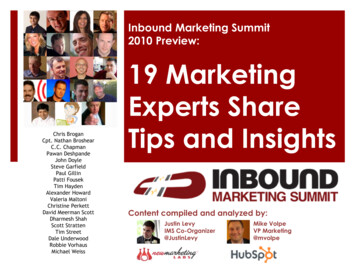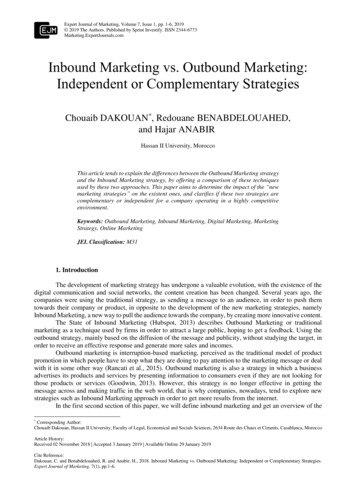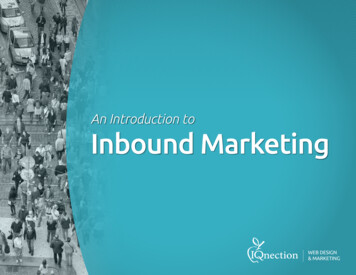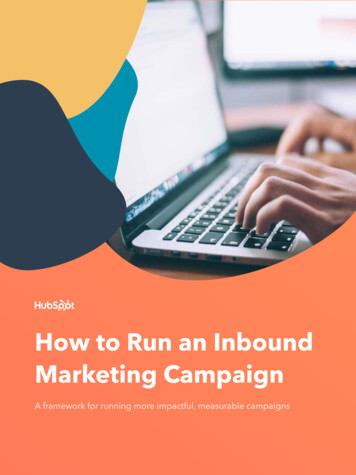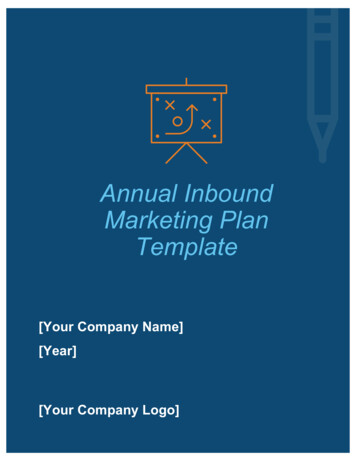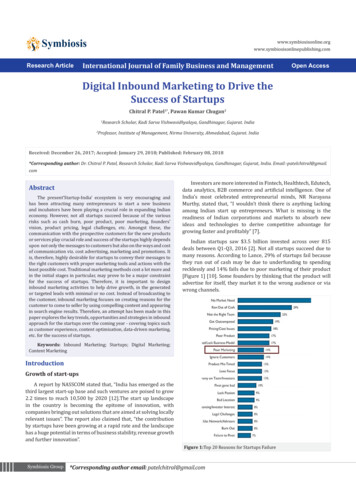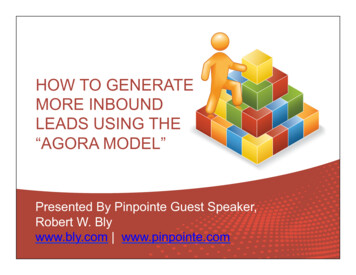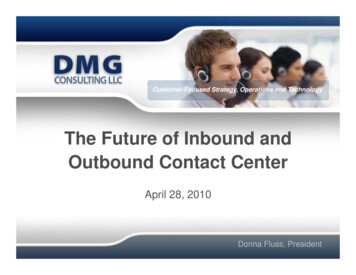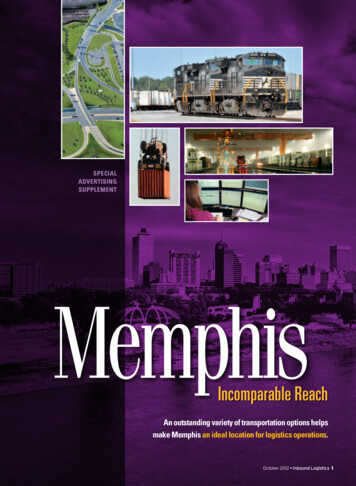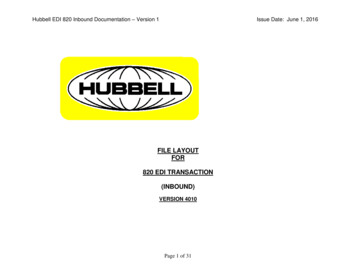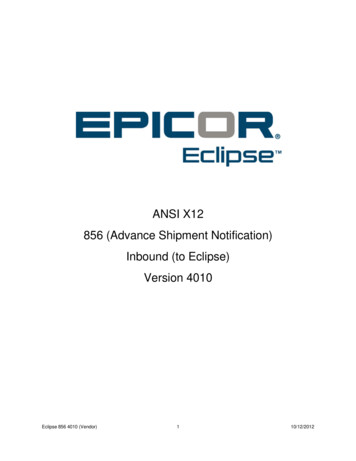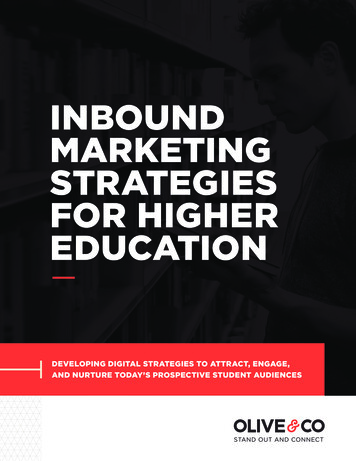
Transcription
INBOUNDMARKETINGSTRATEGIESFOR HIGHEREDUCATIONDEVELOPING DIGITAL STRATEGIES TO ATTRACT, ENGAGE,AND NURTURE TODAY’S PROSPECTIVE STUDENT AUDIENCES
INDEXHOW TO GET THE MOST OUT OF THIS EBOOK03 OVERCOMING HIGHER ED MARKETING CHALLENGES04 WHAT IS INBOUND MARKETING?06 IS INBOUND MARKETING RIGHT FOR MY INSTITUTION?08 SETTING GOALS12 CREATING PERSONAS15 MAPPING YOUR PROSPECTIVE STUDENT JOURNEY17 ASSESSING YOUR CONTENT19 THE INBOUND MARKETING STRATEGY BLUEPRINT21 GETTING STARTED23 612 379.3090www.oliveandcompany.com2
HOW TO GETTHE MOST OUTOF THIS EBOOKBefore diving into inbound marketing, here’s a quicklook at how to best utilize this ebook. We created aninformative and actionable format to advance yourunderstanding of inbound marketing and help you applythat knowledge to your own marketing strategy. Thereare two types of sections you’ll encounter:FUNDAMENTALSPROCESSESThe Fundamentals sections guide you throughinbound marketing theory to help youunderstand how the methodology can work forcolleges and universities. This information isprovided to help you fully understand how yourinternal team and prospective students canbenefit from implementing the methodology.The Processes sections help you applyinbound principles to your marketing effortsby drawing on the information provided in theFundamentals sections. Each section will walkyou through the process of creating tangibledeliverables that can be leveraged to meet yourmarketing and enrollment goals.612 379.3090www.oliveandcompany.com3
OVERCOMING HIGHER EDMARKETING CHALLENGESWorking at a college or university today presents acombination of challenges never before seen in thehistory of higher education in America.Since 2010, more students than ever before aregraduating high school, but fewer and fewer ofthem are going on to enroll in postsecondaryeducation.1 Around half of the students whodo enroll drop out or put their studies on holdbefore actually earning a degree or credential. 2And of those who do graduate, 70 percent willhave financed all or part of their degree throughstudent loans, which saddles new graduateswith debt before they're able to build a financialfoundation for themselves. 3These factors weigh heavily on the minds ofprospective college students and contributeto growing numbers of them pursuingacademic opportunities outside traditionalpostsecondary education; In some cases,they're second-guessing the value of a collegedegree altogether.Meanwhile, higher education marketingdepartments across the country are seeingenrollment goals grow, marketing budgetsshrink or stagnate, and a multitude ofmodalities by which students can earn a degree.Traditional four-year colleges are seeing careercolleges, trade schools, community colleges,and online colleges cut into their oncedominant share of degree seekers.The bottom line is this: Regardless of category,higher ed institutions are working harder andharder to compete for a pool of candidates thatis savvy, selective, and shrinking. Targeting theright audience is only the tip of the iceberg.ONE COLLEGE SAW ITSENROLLMENT FIGURESINCREASE 2.5X MORE THANTHE NATIONAL AVERAGEAFTER IMPLEMENTINGINBOUND MARKETING.4612 379.3090www.oliveandcompany.com4
If you’re like our higher education clients,the biggest challenges you face include: Standing out in an increasinglycompetitive landscape Combating declining enrollmenttrends Connecting with diverse,nontraditional audiences Battling misconceptions about thevalue of a degree Proving the value of new or innovativemarketing initiatives Achieving objectives with limitedmarketing resourcesOvercoming these challenges may seem likea daunting task, but we’re here to help. Theright marketing approach can help you betterconnect with your audience, communicate yourschool’s unique story, participate in open andconstructive dialogue, and ultimately, meet yourinstitutional goals.Since the early 2000s, a marketingmethodology called “inbound marketing”has been proving its value in the highereducation sphere. It’s a strategy based onattracting prospective students by creatinginformative content, optimizing it for maximumperformance, measuring the results of yourefforts, and applying those learnings tofuture initiatives.One Tennessee-based college saw enrollmentincrease 2.5 times more than the nationalaverage after implementing inbound marketing.All told, it saw a 225 percent return on itsinbound marketing investment.4We’ll use this ebook to dig deeper into inboundstrategies; identify ways for you to build yourown process; and explore opportunities foryou to use the methodology to overcomethe unique challenges facing your collegeor university.“The mandate for all institutions has evolved—and that includeshigher education. Therefore, our old way of working ascommunicators and marketers simply cannot succeed. In thismoment, what is necessary is a more ambitious role for highereducation, to build authentic engagement with society, to reimagineyour role, to have a greater impact on real world issues.”5– Richard Edelman1. https://nces.ed.gov/fastfacts/2. /tomorrows-college/dropouts/3. -the-expense-yes-it-is.html4. e5. f-fifth-estate-speech/612 379.3090www.oliveandcompany.com5
FUNDAMENTALS:WHAT IS INBOUND MARKETING?In simplest terms, inbound marketing is a digitalmarketing methodology that leverages quality content,search engine optimization, and lead nurturing tactics toattract consumers to your brand and keep it top of mindas they are making buying decisions.Inbound marketing enables college marketingteams to entice and engage audiences bycreating content that provides objective,trustworthy answers to the questions they’reasking at each stage of the buyer journey. Forcolleges and universities, inbound marketingis about empowering prospective students,and the people that influence them, to makeinformed decisions about their academic futures.Inbound does this by leading prospectivestudents through four phases—attract, convert,close, and delight—that are designed totransform them from strangers, to prospects,to engaged students, to proud alumni andadvocates for your school. As an inboundmarketer, you’ll create and deliver contentthat is strategically aimed at the appropriatestage for that particular person or segmentof users. Meanwhile, you’ll collect data, trackperformance of your content, and optimize it toensure it resonates with the right audience atthe right time.WHY IS INBOUNDMARKETING ESSENTIAL?You likely have a marketing strategy in placethat has served your college for years. Astrategy comprised of basic digital marketingtactics like social media and a pay-per-clickWHAT ABOUT MY OUTBOUNDMARKETING STRATEGIES?Though inbound is a powerfultool, it shouldn’t be the only onein the marketer’s toolbox. Youdon’t need to chuck your provenstrategies out the window.Inbound marketing can beused to complement your othermarketing efforts.612 379.3090www.oliveandcompany.com6
(PPC) campaign alongside traditional marketinglike direct mail, billboard buys, radio spots,and television commercials. You probablyknow exactly what you can and cannot expectfrom your marketing efforts. So, why are werecommending you evolve your strategy?Because students demand it.Most of your prospective students grew upon technology; they’re digitally savvy, theywant information immediately, and they’recomfortable using search engines to findanswers to their questions. Yours is a targetaudience that can expertly spot sponsoredcontent, can deftly defy traditional advertising,and is married to its mobile devices.You’ll create blog posts, landing pages, socialmedia, videos, infographics, ebooks, andwhite papers to provide the best answersto the questions your audience is asking. Indoing so, you’ll build credibility and authorityfor your institution, which then builds trustin your brand. By becoming a resource foryour audience, you’ll be top of mind whenprospective students are ready to make anenrollment decision.INBOUND STATISTICS FOR HIGHER ED97 %of students find collegewebsites to be reliable sourcesof information 63XInbound leads are 3x morequalified than applicantsacquired through traditionalmethods 87XSchools using inboundmarketing are 7x more likely toreport higher ROI than schoolsusing outbound marketing 8MODERN AUDIENCE BEHAVIOR86 %of people skip TV ads44 %of direct mail is never opened 684 %of audiences 25-34 years oldhave left a favorite website dueto intrusive advertising76INBOUND MARKETING ISA PROVEN STRATEGYBy carefully creating content and distributingit on the right platforms at the right time,you’re meeting your consumers where they’remost comfortable and you’re enticing themto connect with you. Rather than pushingyour messaging on people through traditionalmarketing methods, you’re pulling prospectstoward your brand because of the quality ofinformation you’re providing.What’s more, inbound marketing produces moreleads, which improves the ROI of your marketingefforts, and it costs less. That’s right, inboundmarketing costs on average 61 percent less, perlead, than traditional marketing.9In the immortal words of New York Timesbestselling author and all around marketingguru, Guy Kawasaki, “If you’ve got more moneythan brains, use outbound marketing. If you’vegot more brains than money, focus on inboundmarketing.”6. ingforhighereducation7. rketing/8. imateGuideToInboundMarketingForSchools.pdf9. 612 379.3090www.oliveandcompany.com7
FUNDAMENTALS:IS INBOUND MARKETING RIGHTFOR MY INSTITUTION?Higher education institutions are positioned perfectlyto reap the benefits of inbound marketing. Theinbound methodology is built around creating contentthat answers the questions consumers are askingand—because current and prospective students spendsignificant amounts of time and energy comparingand contrasting academic options—it offers a greatway to attract, entice, engage, and retain them.Equally as important, inbound marketingprovides a mechanism through which collegesand universities can reinforce their values,communicate their philosophies, and sharethe student experiences that are relevantto prospective students considering theirinstitution.INBOUND MARKETING FOR4-YEAR COLLEGESStudents considering these schools are mostlikely between the ages of 18-24 at the time ofmatriculation and they spend time—perhapsmore than any other cohort of prospectivestudents—comparing and contrasting theiroptions. Inbound marketing can help four-yearschools differentiate themselves in the minds ofprospective students by showcasing the uniqueconvergence of academic, geographic, social,and extracurricular experiences offered.INBOUND MARKETING FORFAITH-BASED COLLEGESStudents considering faith-based colleges oftendo so because the values around which theschool was built resonate with their own valuesand inspire them to continue their spiritualjourney alongside their academic one. Inboundmarketing can help communicate thosemessages to prospective students and positiontheir academic experience as a launching padfor a life of success, service, and stewardship.INBOUND MARKETING FOR CREATIVEARTS COLLEGESStudents considering these institutions areseeking a traditional academic experience thatprepares them for nontraditional, creative artscareers. Inbound marketing can help highlightthe multitude of academic opportunities thatexist in these fields, share student successstories, and illustrate the types of careersavailable to creative and interdisciplinary artsdegree holders.612 379.3090www.oliveandcompany.com8
FUNDAMENTALS:IS INBOUND MARKETING RIGHTFOR MY INSTITUTION?INBOUND MARKETING FORCOMMUNITY COLLEGESINBOUND MARKETING FORCAREER COLLEGESStudents considering community colleges aren’tlooking for destination campuses—they wantacademic options that are close to the placesthey already live, work, and play. Communitycolleges are relying more and more heavilyon inbound marketing to refute the stigma ofbeing the “fallback” options for students onthe academic bubble. To do so, they’re usinginbound to illustrate the multitude of programsavailable and highlight the advantages of aquality education within close proximity tohome.Career colleges were among the first highered institutions to adopt inbound marketingstrategies to recruit new students. In addition tohelping meet enrollment goals, some of theseschools have used inbound effectively to battlemisconceptions about the value of the degreesthey offer.INBOUND MARKETING FORTRADE SCHOOLSStudents considering these schools often doso because the length of time to completionis shorter, their career path is chosen priorto matriculation, and the hands-on learningstyle is more attractive than classroom-basedlectures. Inbound marketing that integratesvisual content can be very effective in helpingillustrate the advantages of trade schools, thehands-on learning environment available, andcareer outlook information to help them decideon the right path for them.Students considering these schools often do sobecause they offer attractive modalities—i.e.,fully online or hybrid online/onsite degrees—designed for speed and convenience. Inboundmarketing can help communicate the waysin which a college degree can help busyprofessionals advance in their current career orchange to a more lucrative or satisfying one.INBOUND MARKETING FORGRADUATE PROGRAMSStudents considering graduate degreesoften do so because they want to helpadvance a field of study or achieve a level ofprofessional development or prestige. Inboundmarketing can help attract and entice newstudents by showcasing the sense of personalaccomplishment, the cutting-edge facilitiesand research, and the professional advantagesinherent in earning an advanced degree.612 379.3090www.oliveandcompany.com9
FUNDAMENTALS:THE INBOUND MARKETING METHODOLOGYNow that you’ve been introduced to inbound marketingand understand why it is essential to higher ed marketingteams, let’s dive into the methodology that makes it sosuccessful. To recap, inbound marketing involves creatingrelevant content that empowers prospective students tomake informed decisions about their academic futures.This approach consists of four phases.ATTRACTWEBSITEVISITORSSTRANGERS KeywordStrategy High-QualityContent CONVERTSocial TSALUMNI Gated Content ent Email Nurturing Landing Pages MarketingAutomationSocialMonitoring Survey Insights 612 379.3090www.oliveandcompany.com10
1ATTRACTThe attract phase of the inbound methodologyuses content to answer the questions peopleare asking about higher education online and insearch engines. You’re meeting strangers wherethey are in their journey and attracting themto your website. By being a source of objectiveinformation for this audience, you’re buildingcredibility for your school and trust in your brand.2CONVERTThe goal of the convert stage is to transformwebsite visitors into prospective students.Landing pages containing relevant, nonpromotional content offers, RFI forms, andenticing CTAs are used to gather personalinformation from visitors interested in engagingwith your school. This is the stage in which youidentify the “right” leads for your particularinstitution.3CLOSEThe close phase is where prospective studentsbecome applicants, and ultimately, enrolledstudents. Personalized email campaigns,branded content, and direct social mediainteraction can be used to help prospects makeenrollment decisions and nurture them as theyprogress toward matriculation.4DELIGHTThe inbound marketing methodology doesn’tend after the student decides to enroll. Thedelight phase is all about building long-lastingrelationships with your students, alumni, andcommunity members so they ultimately becomeadvocates for your institution. Relationshipbuilding surveys, social media, alumni outreach,and email newsletters can all be used todrive advocacy.WHAT’S THE DIFFERENCEBETWEEN CONTENTMARKETING AND INBOUNDMARKETING?It’s important to clarify, inboundmarketing is not the same ascontent marketing, rather, oneis a component of the other.Content marketing is aboutcreating and curating content toencourage users to take a specificaction. Inbound marketing, on theother hand, is a methodology thatuses various marketing tactics—content, email, SEO, social media,to name a few—at strategicpoints in the buyer journey totransform visitors into applicants,applicants into students, andstudents into advocates for yourinstitution. Each phase of theinbound methodology relieson content marketing to moveprospective students through thebuyer journey.612 379.3090www.oliveandcompany.com11
PROCESSES:SETTING GOALSA crucial component of inbound marketing is identifyingthe metrics that will help define success or failure ofyour strategy. Metrics that colleges and universities findvaluable often include traffic, leads, starts, enrolls, timeon page, page depth, click-through rate, new versusrepeat visitors, bounce rate, and comments.Once you identify the right metrics, you can begin tracking the performance of specific sectionsof your site, categories of pages, individual pieces of content, and anything else that helps youunderstand whether or not your inbound efforts are working. The end goal is to gather the type ofdata that yields insights and, ultimately, drives institutional decisions.Keep in mind, the goals you set should be SMART—specific, measurable, attainable, relevant, timely.There are a lot of components contributing to the success or failure of your marketing efforts, and youneed to be able to quickly and easily separate strategies that work from those that don’t. SMART goalswill help make sure you’re positioned to reach the right audiences at the right time.1GOALS SHOULD ALWAYS BE municateswho, what,where, when,and why.Possible totrack progressfor data.Realisticallyachievable foryour team.Addressescore businessand brandobjectives.Includesfinite dateto completethe goal.EXAMPLESMART GOALIncrease starts 3 percent year-over-year by the end of the 2018 admissions cycle.612 379.3090www.oliveandcompany.com12
2INVOLVE THE ‘RIGHT’ STAKEHOLDERS IN YOUR PROCESSIt’s important to share your plan with internal stakeholders to gain alignment and ensure your goals arecomprehensive, but don’t overdo it. You don’t want to solicit feedback from everyone from marketingto administration to faculty to admissions. You just need to make sure that the stakeholders directlyimpacted by your plan—and those responsible for approving or denying it—have been consulted andbeen given a chance to provide input. This ensures internal buy-in while also protecting your plan fromarbitrary or subjective preferences.3DEFINE YOUR GOALSOnce the right stakeholders are involved in the goal-setting process, host a brainstorm session to delveinto the reasons for building an inbound marketing strategy and how it will benefit the school. This isa good opportunity to identify and address areas of confusion or misunderstanding, as well as gainfurther alignment. Let these three questions guide your brainstorm session.QUESTION 1WHAT IS THE CURRENT STATE OF YOUR MARKETING?It is very important that the answer to this question is candid. It doesn’t help tosugarcoat anything at this stage. An honest assessment here will help you createSMART goals that can be applied across the institution.QUESTION 2WHAT ARE YOUR MARKETING, ADMISSIONS, AND ENROLLMENT GOALS?Your answer may be to attract more prospective students, drive brand awareness,or be seen as a pillar in your community. Whatever your goals are, the answer to thisquestion will drive your entire strategy, so be thorough, and make sure to documentthem clearly.QUESTION 3WHICH METRICS WILL BEST ILLUSTRATE SUCCESS OR FAILURE?To identify meaningful metrics you need to know what is worth measuring. If youcan’t answer the following questions about your school’s marketing efforts, thesemight be metrics you want to measure:1.How much traffic is your website driving?2.How many leads are you generating from the site per month?3.What is the lifetime value of a lead at your college?4.What is the open rate of your email newsletter?5.How do current numbers compare to historical data?612 379.3090www.oliveandcompany.com13
4DOCUMENT YOUR GOALSDon’t make the mistake of letting a greatbrainstorm session be reduced to vaguerecollections or cobbled together in an endlessemail stream. Be intentional about documentingyour goals. If necessary, invite someone toyour brainstorm session whose sole purposeis to record insights and assign action itemsafterwards. If you used a whiteboard for yoursession, before erasing it, use your smartphoneto take a picture of it and send it to meetingattendees. Documenting your goals will ensureyour inbound strategy has a clear purpose andwill establish a path to success.5GET THE LARGER TEAM ON BOARDOnce you’ve documented your goals,share them across all stakeholder teams.Documented goals keep everyone on thesame page and accountable for success orfailure. Communicating throughout the processis especially important if inbound is a newmarketing approach for your team.The SMART goals you set will inform everystrategic inbound marketing decision youmake and they will be used to evaluate theeffectiveness of your inbound efforts. Keep inmind, inbound is a complex process built aroundhuman behavior so you may not reach yourgoals right away. It requires testing, analysis,reiteration, and ongoing optimization. Thatmeans you’ll adjust your goals as you go andcontinuously work toward better results.HOW DO I KNOW IF I AM REACHING MY GOALS?Essential components of inbound marketing are collecting data, measuring performance,drawing insights from your data, and assessing progress toward your goals. If you don’thave a data expert on your team, don’t worry. Use an inbound platform like HubSpot todocument your goals and execute on your inbound marketing strategy.With many platforms, you’ll automatically receive analytics, including website traffic,email click-through rate, time on site, and bounce rate. After reviewing site performance,feel free to adjust your goals and alter your campaigns to consistently improve yourinbound efforts.612 379.3090www.oliveandcompany.com14
PROCESSES:CREATING PERSONASTo effectively create content that is optimized foreach stage of the enrollment journey, you needto know what types of content and messages willresonate with the various segments within your targetaudience. This knowledge comes from understandingyour audience’s wants, needs, challenges, painpoints, motivations, and goals. This information isdocumented in the form of personas.WHAT ARE PERSONAS?Personas are archetypes of the various peopleyou’re targeting with your marketing. Personasare created using a combination of quantitativeand qualitative data analysis that allows you tounderstand your consumers’ online behavior anduse it to predict future interactions.For example, if one of the populations you’retrying to target is Generation Z consumers (i.e.,those born after 1999), the persona you createshould embody the shared characteristics andconcerns that define them—e.g., social justice,activism, volunteering, digital multitasking,entrepreneurship, and privacy. As a highereducation institution, your consumers might allbe Gen Z’ers, but the information that motivates,frustrates, and resonates with them may bedifferent based on their specific concerns and lifeexperiences. So the content that appeals, attracts,and entices them also needs to be different.Segmenting personas based on sharedcharacteristics and concerns, rather thandeferring simply to age, race, gender, orgeography-based demographics, builds a betterconnection between you and your audience, anddrives more effective content creation.HOW TO BUILD PERSONAS1CONDUCT RESEARCHConduct research to figure out who is alreadyinteracting with your brand. Talk to admissionsteams, study your social media interactions, lookat your website analytics. Ask questions aboutyour audience’s wants and needs in relation to thecollege selection process: What causes them stress? What does a day in their life look like? What are their challenges and pain points? How do they find and share information? What common questions do they have?612 379.3090www.oliveandcompany.com15
2IDENTIFY YOUR TARGET AUDIENCEIdentify your target audience in its broadestsense, e.g., “prospective students.” Segment itinto multiple personas you can use to developspecific insight into their wants, needs, goals,challenges, etc. In this example, your personascould include: Gen Z’ers Single parents Career changers Adult learners43BUILD PERSONASUse creativity, insights, and data to define thecommon challenges, desires, and questionseach of your segments share. Build profilesaround those characteristics. Combine a name,photo, age, gender, and bio with each segments’wants, needs, challenges, preferences, sourcesof information, influencers, and any otherinformation that is relevant to their decisionmaking process. Your personas will start to takeshape as you identify areas of distinction andoverlap between them.USE PERSONAS TO ACHIEVE BUSINESS GOALSOnce you build and document your personas, share them with your larger marketing, admissions,enrollment, and leadership teams. The work you do at this stage should be used to inform futuremarketing materials, campaigns, and collateral. Keep in mind, as time passes and organizationalpriorities shift, audiences may change. Use the data you collect from your inbound efforts toupdate your personas as they evolve.EXAMPLE PERSONA612 379.3090www.oliveandcompany.com16
FUNDAMENTALS:MAPPING YOUR PROSPECTIVESTUDENT JOURNEYNow that you’ve defined your target audience, and havebegun building out personas, one of the key componentsto segmenting your audience is recognizing their uniquejourney, or, the individual factors that influence thedecisions they make.Fully understanding the prospective student journey will help you design an inbound strategy thatresonates with the audience you’re targeting at the time they’re searching for information. Eachpersona within your audience will likely experience a different journey, so it’s important to thinkcritically and creatively when defining them.THE INBOUND METHODOLOGY VS. THE PROSPECTIVE STUDENT JOURNEYUnderstanding the relationship between theinbound methodology and the prospectivestudent journey is vital to developing a targetedinbound strategy.The inbound methodology—attract, convert,close, and delight—outlines the selling processhigher ed marketers use to transform strangersinto students, and alumni into advocates.The prospective student journey—awareness,consideration, decision—is the internal thoughtprocess a person works through as they comparetheir higher education needs with the college oruniversity that best meets those needs.As you’re ushering prospective students throughthe inbound stages, they may be in differentstages of their own journey. Each persona movesthrough the journey at their own pace so somemay take longer to consider, while others mayjump quickly to a decision. Inbound contentshould be created to help guide students throughtheir decision-making process by providing theinformation they’re seeking.IS SELECTING A COLLEGE APURCHASE DECISION?Choosing a college is a purchasingdecision—a highly important andemotional decision, with a largeprice tag to boot. Prospectivestudents choose from a large poolof potential colleges that meettheir academic needs. When theychoose to apply and eventuallyenroll, they are purchasingacademic services that canimpact the rest of their lives. Byunderstanding the prospectivestudent journey, you can use yourmarketing efforts to help guide thislife-changing decision process.612 379.3090www.oliveandcompany.com17
STAGES OF THE PROSPECTIVE STUDENT tunityCONSIDERATIONConsidering/comparing optionsDECISIONTaking action tosolve problem/pursueopportunityDuring the first stage of their journey, your personas are onlytangentially aware they have a need to fulfill or an opportunityto pursue (e.g., I want a sense of accomplishment). Sometimes,people in this stage just know they need a change. They’re notlooking for solutions in the awareness stage, they’re merelyexploring their situation at an abstract level and are trying to fullyunderstand the next step that makes the most sense for them.Top-of-funnel content that is non-promotional and designedto spark interest, entertain, or answer a basic question is whatresonates best with visitors in this stage.The consideration stage is when visitors fully understand and canarticulate their need or problem. They are actively researchingmeans and methods to answer their question, meet their need,or solve their problem (e.g., Does degree A or degree B havea better career outlook?). This is the stage in which visitorsbecome prospective students and begin separating the collegesthey’re interested in from those they aren’t. It’s important to note,prospective students in this stage are keeping their options openand are gathering information, so content here should be thoroughand comprehensive. Middle-of-funnel content designed to educatereaders and answer multiple questions will resonate best withprospects in this stage.The decision stage is when prospective students will create a shortlist of options that best meet their academic and situational needs(e.g., Local colleges and universities that offer g
612 379.3090 www.oliveandcompany.com 2 how to get the most out of this ebook 03 overcoming higher ed marketing challenges 04 what is inbound marketing? 06 is inbound marketing right for my institution? 08 setting goals 12 creating personas 15 mapping your prospective student journey 17 assessing your content 19 the
